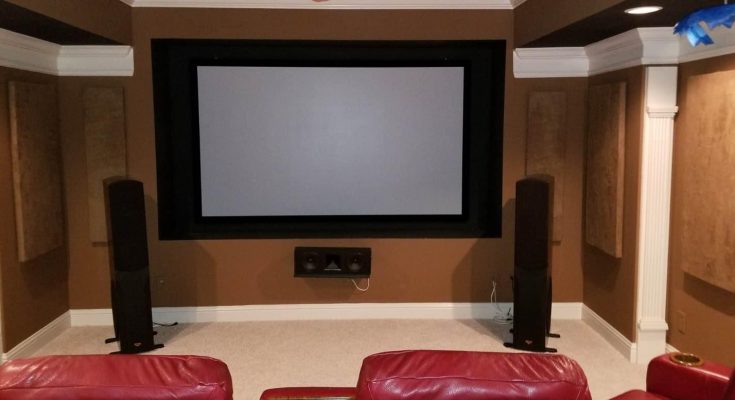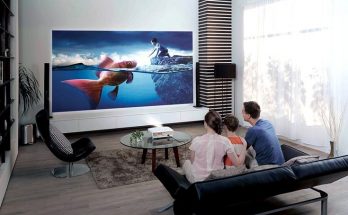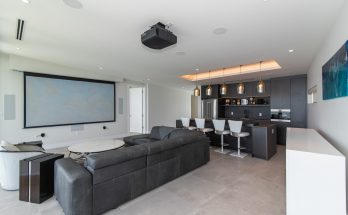The answer is that the picture quality is improved as the room becomes darker. Usually, darkness is essential for a projector to produce bold and drift-free images for contrast. Furthermore, shadows will also allow color standards to be established more quickly.
It can be said that basements are highly recommended for projector placement because of their natural darkness. Instead, you can also install your beloved projector in a bedroom with a window so you can ensure just the right amount of light into the room. In most ordinary homes, the tool to reduce the light entering a room is the curtains, which will successfully block light for your projector to project the best image.
Previously, projector brightness (or lack thereof) necessitated a completely black room. Still, today’s projectors provide more light for your dollar than ever before. Thanks to improved technology, including screens that reject ambient light, it’s simpler to locate a model that can tolerate moderate ambient light or even well-lit areas.
More importantly, the projector will deliver the best image quality when performed in projection room lighting. However, for offices and meeting rooms, we need light to record work and observe the surroundings. Therefore, a projection room cannot turn off the projector or the window to dim; we need a projector with higher brightness to meet it. But if a dark room but we re-up the select one the hosted to the light up to make the view will be my current eye. Therefore, we need to evaluate the lighting environment where the projector is placed as a critical condition in selecting a suitable projector.
How to help projector work best in any lighting environment
Here are some suggestions for getting the most out of your projector in any room setting:
Choose the ideal room for your needs
Because basements are frequently utilized as movie rooms, basement projectors are the most popular. With the availability of darkness and windows, they are ideal for your storage. Should you don’t have access to a basement, black-out shades can be purchased to darken a space regardless of the time of day.
Carefully read the projector’s instructions before using it
A handbook or an electronic format manual is included with every projector. The guide is the essential resource you should have on hand. Before utilizing the projector, set aside some time to read over it thoroughly. The instructions will show you how to utilize your projector to its full potential. All projector model has its settings and features, which may be different from what you’re used to.
Take into account the projector’s location
Actually, you may get more projector placement than merely putting it where you think it’ll look good. Avoid placing your projector in a crowded area. Allow for appropriate airflow by leaving 6 to 12 inches of space around your projector, as any setup of heat can quickly harm your projector’s internal components, shortening its lifespan.
Place your projector away from direct sunlight and away from an outgoing vent. It’s also a good idea to maintain the area around your projector clean of dust and grime to ensure optimal operation.
Control the amount of light in the room
Control the ambient light from any overhead lights to obtain optimal projection. Cover windows or prevent direct sunlight from keeping light off the screen.
Maintain the cleanliness of your projector’s filter
Filters for projectors are essential for preventing dust accumulation. They can insulate your projector if left uncontrolled. Clean the projector filters at least once every three to four months.
Another option is to use pressurized air from a can to blow away any dust accumulated in the filters. Instead, use a handheld vacuum cleaner to clean the dirt from your filters thoroughly. Filter debris can have a significant influence on the image quality produced by your projector.
Choose the proper picture mode
Choose the appropriate option for the amount of lighting in your space to get the best possible image. When the room is dimly illuminated, a Movie or Cinema is the best image quality option. To bring out crisp photos and movies in low light, use a brighter setting.
FAQs
Should I buy a high-brightness projector for meeting rooms and halls?
There is almost no LED projector in a space with much natural light and a large area that can meet projection well on a 135inch projection screen. Since most projectors using LED bulbs are usually mini projectors or have a very low luminous intensity, just under 1,000 Ansi Lumens. While with the space as above, it is necessary to have a projector using a UHP lamp with a luminous intensity of 3500 Ansi Lumens or higher and a standard resolution of 1024×768 or higher. If it’s possible, buy an HD projector (1280×800) that will give a better definition.
What’s the best way to get my projector to function in daylight?
If you want to use a projector outside during the day, make sure it has a brightness output of at least 3,000. This level of brightness is required to watch the film. Additionally, providing shade, securing the screen, and placing the projector in a shady part of the garden can all assist.
What level of brightness do I require from my projector?
When it comes to projector brightness, only one approach does not apply. Several elements must be considered to determine the amount of brightness or lumens required from your projector. The picture width, throw distance, ambient light in the space, and the material you’ll be presenting are all factors to consider. To figure out what will work for you, use a projection calculator given by your manufacturer. Here are some lumen numbers that may be useful to you:
- Consider lumens of 20,000 or more for a movie theater or stadium.
- A living room with 1,500 to 2,000 lumens of light that can be turned off entirely can provide bright and crisp visuals and movies.
- For a classroom or boardroom with dimmable lights, at least 3,000 lumens are required.
- With 4,500 lumens, a projector can best serve an ample space with intense ambient light, such as a church or lecture hall.
Conclusion
It’s critical to match your projector to the location where you’ll be using it the most. Depending on the lighting conditions in the room, it should give you the appropriate picture brightness. When it comes to projecting, different projectors have different light intensities, which are measured in lumens. The projector will be brighter if these lumens are higher.
Bright projectors are becoming more popular, particularly for use in conferences and educational presentations. This is due to their capacity to display good pictures even when the lights are turned on in a room. The brightness of the projector, on the other hand, has no particular setting.





